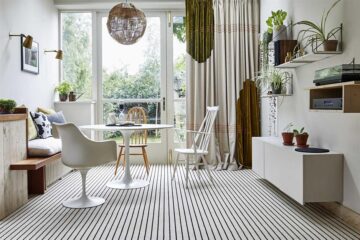Creating a healthy, relaxing place in your home to reduce anxiety is not difficult peaceful and relaxation spaces can be created in your available in space but everyone’s home is different and therefore have their own needs. One needs a private location for oneself during their ME time, but if they utilise it for business as well, it might stop being pleasant.
“Just like with any habit, building an anxiety-reducing space at home involves practise,” said Charu Gupta, interior designer and director of L’ Institution De Dessins (LIDD), in an interview with HT Lifestyle. Regularly using the area in a way that makes you feel more at ease and refreshed is required. You must establish a calm haven that will transform your constructed environment into a haven of relaxation if you want to lessen worry.
She offered the following suggestions for effective interior decorating:
1. Interior plants: In addition to adding greenery and filling empty areas, indoor plants can help you feel more connected to nature, which lowers stress and anxiety. They foster a serene and nurturing atmosphere. Within, they take in carbon dioxide and expel oxygen. Taking in the greenery surrounding you improves your mood. A body of water might also be added for the soothing sound of water. If for whatever reason you are unable to keep plants indoors, consider adding a beautiful wallpaper or paintings.
2. Declutter: Having clutter in your home is one of the main causes of worry. One doesn’t want to feel anxious and cramped. An open area appears friendly. Get rid of anything you don’t use or need. You can donate or store items for charity. Decorate your home with items you love or appreciate; they will help you remember the good times and calm you.
3. Colors: Colors have a strong psychological impact since they arouse sensations and stimulate memories or feelings. Be careful when choosing colours because too much brightness might inspire rage and violence while too much dullness can be sad.
4. Bathroom: Warm colours and whites, which are associated with cleanliness and purity. The colours blue, green, and turquoise provide a feeling of cleanliness, freshness, and calmness.
5. Bedroom: Because they are supposed to have a relaxing impact, cool colours like blues, greens, and lavenders can make excellent choices here.
6. Dining room: A formal dining room can look fantastic with red decor. It also piques your guests’ interests while fostering conversation.
7. In the home office, green symbolises concentration. One of the nicest hues to spend a lot of time around is this one.
8. Yellows are fantastic colours for the kitchen since they boost appetite.
9. Living room and foyer: Since they encourage conversation, warm colours like reds, yellows, and oranges as well as earth tones like brown and beige frequently work well in both the living room and foyer.
10. Lighting: Both physical and mental effects are caused by light. When we enter a room, lighting gives us energy and communicates mood and expectations. Just the right amount of illumination should be used. Brightness tends to incite hostility and heat in a space. Dimming the lights helps one to relax and stay calm. Natural light, which is only available during the day, is the best.
You may make your living room calm and stress-free so that you can unwind and recharge by using these suggestions. Your home should be a haven of peace and comfort, whether you’re reading, doing meditation, or just relaxing on the couch.
source from: msn.com

